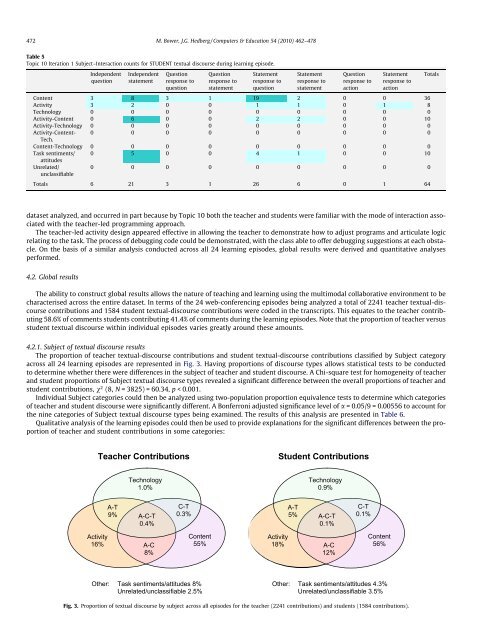A quantitative multimodal discourse analysis of ... - Anitacrawley.net
A quantitative multimodal discourse analysis of ... - Anitacrawley.net
A quantitative multimodal discourse analysis of ... - Anitacrawley.net
Create successful ePaper yourself
Turn your PDF publications into a flip-book with our unique Google optimized e-Paper software.
472 M. Bower, J.G. Hedberg / Computers & Education 54 (2010) 462–478Table 5Topic 10 Iteration 1 Subject–Interaction counts for STUDENT textual <strong>discourse</strong> during learning episode.dataset analyzed, and occurred in part because by Topic 10 both the teacher and students were familiar with the mode <strong>of</strong> interaction associatedwith the teacher-led programming approach.The teacher-led activity design appeared effective in allowing the teacher to demonstrate how to adjust programs and articulate logicrelating to the task. The process <strong>of</strong> debugging code could be demonstrated, with the class able to <strong>of</strong>fer debugging suggestions at each obstacle.On the basis <strong>of</strong> a similar <strong>analysis</strong> conducted across all 24 learning episodes, global results were derived and <strong>quantitative</strong> analysesperformed.4.2. Global resultsThe ability to construct global results allows the nature <strong>of</strong> teaching and learning using the <strong>multimodal</strong> collaborative environment to becharacterised across the entire dataset. In terms <strong>of</strong> the 24 web-conferencing episodes being analyzed a total <strong>of</strong> 2241 teacher textual-<strong>discourse</strong>contributions and 1584 student textual-<strong>discourse</strong> contributions were coded in the transcripts. This equates to the teacher contributing58.6% <strong>of</strong> comments students contributing 41.4% <strong>of</strong> comments during the learning episodes. Note that the proportion <strong>of</strong> teacher versusstudent textual <strong>discourse</strong> within individual episodes varies greatly around these amounts.4.2.1. Subject <strong>of</strong> textual <strong>discourse</strong> resultsThe proportion <strong>of</strong> teacher textual-<strong>discourse</strong> contributions and student textual-<strong>discourse</strong> contributions classified by Subject categoryacross all 24 learning episodes are represented in Fig. 3. Having proportions <strong>of</strong> <strong>discourse</strong> types allows statistical tests to be conductedto determine whether there were differences in the subject <strong>of</strong> teacher and student <strong>discourse</strong>. A Chi-square test for homogeneity <strong>of</strong> teacherand student proportions <strong>of</strong> Subject textual <strong>discourse</strong> types revealed a significant difference between the overall proportions <strong>of</strong> teacher andstudent contributions, v 2 (8, N = 3825) = 60.34, p < 0.001.Individual Subject categories could then be analyzed using two-population proportion equivalence tests to determine which categories<strong>of</strong> teacher and student <strong>discourse</strong> were significantly different. A Bonferroni adjusted significance level <strong>of</strong> a = 0.05/9 = 0.00556 to account forthe nine categories <strong>of</strong> Subject textual <strong>discourse</strong> types being examined. The results <strong>of</strong> this <strong>analysis</strong> are presented in Table 6.Qualitative <strong>analysis</strong> <strong>of</strong> the learning episodes could then be used to provide explanations for the significant differences between the proportion<strong>of</strong> teacher and student contributions in some categories:Teacher ContributionsStudent ContributionsTechnology1.0%Technology0.9%A-T9%A-C-T0.4%C-T0.3%A-T5%A-C-T0.1%C-T0.1%Activity16%A-C8%Content55%Activity18%A-C12%Content56%Other: Task sentiments/attitudes 8%Unrelated/unclassifiable 2.5%Other: Task sentiments/attitudes 4.3%Unrelated/unclassifiable 3.5%Fig. 3. Proportion <strong>of</strong> textual <strong>discourse</strong> by subject across all episodes for the teacher (2241 contributions) and students (1584 contributions).
















